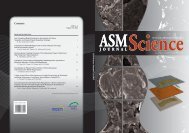in Negara Brunei Darussalam - Portal Rasmi Akademi Sains Malaysia
in Negara Brunei Darussalam - Portal Rasmi Akademi Sains Malaysia
in Negara Brunei Darussalam - Portal Rasmi Akademi Sains Malaysia
You also want an ePaper? Increase the reach of your titles
YUMPU automatically turns print PDFs into web optimized ePapers that Google loves.
ASEAN J. Sci. Technol. Dev., 28(2): 103 – 114<br />
Usage of UASB Reactor to Assess Feasibility of<br />
Treatment of Paper Mill Effluent<br />
A. ARSHAD 1 *, N. H. HASHIM 2 , A. Q. INTIKHAB 1 AND N. GHAZALA 3<br />
1<br />
National University of Sciences and Technology (NUST),<br />
Islamabad, (MCE Risalpur) Pakistan<br />
2<br />
Department of Civil and Environmental Eng<strong>in</strong>eer<strong>in</strong>g, UET Taxila, Pakistan<br />
3<br />
Fazia Degree College, Risalpur Cantt, Pakistan<br />
Upflow anaerobic sludge blanket (UASB) reactors R-I and R-II, each with an effective volume of<br />
6.0 l were used to study the treatability of actual effluent obta<strong>in</strong>ed from paper mills at a mesophilic<br />
temperature and neutral pH. Methanol, as a source of an easily biodegradable substance along<br />
with activated carbon of effective size 1.5 mm–2.5 mm were added to the reactor R-I to a total<br />
depth of 12 cm to evaluate its efficiency. The pH of both the reactors were kept constant at neutral<br />
by add<strong>in</strong>g an external buffer solution of 0.03 M NaHCO 3 with the feed solution. It was observed<br />
that correspond<strong>in</strong>g to an organic load<strong>in</strong>g rate of 3.5 kg-COD/m 3 -day, the overall chemical oxygen<br />
demand (COD) removal efficiency of the reactors R-I and R-II were 88% and 64%, respectively.<br />
The absorbable organic halides removal efficiency was observed to be 72% and 47% for reactor<br />
R-I and R-II, respectively. Dur<strong>in</strong>g the study it was however observed that, the treatability efficiency<br />
of reactor R-I was comparatively better but the amount of its biogas production was slightly lower<br />
than that of R-II. The average biogas production <strong>in</strong> reactors R-I and R-II dur<strong>in</strong>g the course of study<br />
was observed as 0.33 l/g-COD removed and 0.42 l/g-COD removed respectively, with a mean methane<br />
composition of 58%–61% <strong>in</strong> both the reactors. K<strong>in</strong>etic coefficients of k, K s , Y and k d were determ<strong>in</strong>ed<br />
to be 0.7 g-TOC/g-VSS.d, 0.30 g-TOC/l, 0.26 g-VSS/g-TOC and 0.02 day –1 respectively, based on<br />
the results obta<strong>in</strong>ed from reactor R-I. The results of this study showed that the use of methanol and<br />
an activated carbon <strong>in</strong> a UASB reactor to anaerobically digest the paper mills effluent at a mesophilic<br />
temperature and a neutral pH reactor was quite a feasible and viable technique.<br />
Key words: anaerobic digestion; activated carbon; methanol; COD; AOX; organic load<strong>in</strong>g rate;<br />
design; parameters, pulp<strong>in</strong>g process; removal efficiency<br />
Develop<strong>in</strong>g nations are highly subject to<br />
extensive environmental pollution, ma<strong>in</strong>ly due<br />
to the discharge of untreated <strong>in</strong>dustrial and<br />
domestic effluent. The paper mill <strong>in</strong>dustry is<br />
considered to be among the top-most pollution<br />
sources and releases a variety of toxic and<br />
hazardous wastes. It creates a massive threat<br />
to the environment by generat<strong>in</strong>g highly<br />
polluted effluent. The bleach<strong>in</strong>g section of the<br />
mill discharges the most toxic type of effluent<br />
conta<strong>in</strong><strong>in</strong>g AOX (absorbable organic halides),<br />
which are produced as a result of the chemical<br />
comb<strong>in</strong>ation of chlor<strong>in</strong>e that comes from the<br />
bleach<strong>in</strong>g section with the residual lign<strong>in</strong> of<br />
the pulp<strong>in</strong>g effluent (Ali et al. 2001; Savant<br />
et al. 2005). AOX are highly hazardous because<br />
the majority of members of this family are<br />
bioaccumulative, persistent and carc<strong>in</strong>ogenic<br />
<strong>in</strong> character. Diox<strong>in</strong>, which is recognized to be<br />
the most deadly substance ever found on earth,<br />
also belongs to the same family of AOX (Arshad<br />
et al. 2009).<br />
A variety of physical, chemical and<br />
biological techniques have been attempted to<br />
decrease the concentration of AOX <strong>in</strong> paper<br />
* Correspond<strong>in</strong>g author (e-mail: aliarshad08@yahoo.com)

















